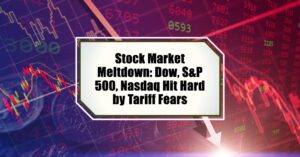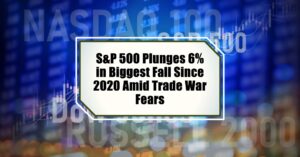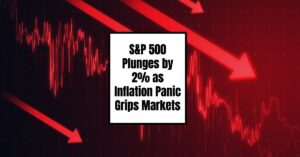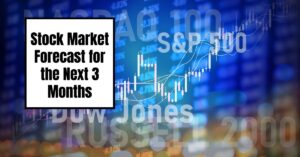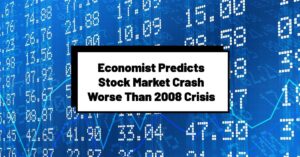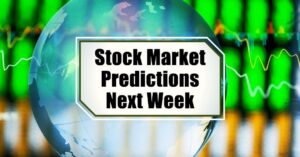Ever feel like trying to predict the stock market is like trying to catch smoke? You're not alone. As of early June 2025, the stock market forecast for the next 6 months presents a fascinating, albeit complex, picture. Following two strong years of growth, with the S&P 500 currently hovering around the 5,983 mark (according to Charles Schwab's analysis on June 6, 2025), investors are understandably keen to understand what the rest of the year might hold.
While the recent past has been bright, a closer look suggests a landscape with both opportunities and potential pitfalls. In short, expect a market that could be range-bound with a slight possibility of a downward trend towards the end of the year, demanding a thoughtful and diversified approach from investors.
Stock Market Forecast for the Next 6 Months (June – December 2025)
A Look at Where We Stand
It's hard to talk about the future without understanding the present. The S&P 500's climb to 5,983 as of June 6, 2025, with a healthy weekly gain, showcases the market's underlying strength. The impressive returns of over 25% in both 2023 and 2024, as highlighted by Morgan Stanley, created a wave of optimism. However, there's a sense of cautiousness in the air. Recent volatility, fueled by global economic uncertainties and simmering geopolitical tensions, has tempered unbridled enthusiasm. Right now, it feels like the market is balancing strong economic data and an inherent bullish sentiment against a backdrop of potential challenges looming on the horizon.
Decoding the Crystal Ball: Expert Forecasts
To get a clearer picture of the stock market forecast for the next 6 months, let's dive into what some of the big players in the financial world are saying:
- Fidelity (June 4, 2025): Fidelity's analysts suggest a range-bound market. They anticipate the S&P 500 will likely trade between its April low of 4,835 and recent highs near 6,000.
- They've revised their earnings growth expectations for 2025 downwards to 7%, from an initial estimate of 12%. This indicates a potential slowdown in corporate profitability.
- Key risks they point to include potentially aggressive tariff policies, rising bond yields (making bonds a more attractive investment compared to stocks), and pressure on stock price-to-earnings (PE) ratios. This last point is crucial – if earnings don't keep pace with stock prices, valuations could become stretched.
- Charles Schwab (June 6, 2025): Schwab's most recent weekly outlook is more upbeat in the short term. They believe the S&P 500 could even test its all-time high of 6,144 in the near future. While they haven't provided a detailed six-month forecast in this particular report, the positive momentum they see suggests the potential for continued growth, driven by solid economic data.
- Morgan Stanley (February 19, 2025): Morgan Stanley predicts more modest gains for 2025 after the exceptional performance of the previous two years.
- They highlight the exciting potential of Artificial Intelligence (AI), suggesting that a surge in productivity driven by AI could mirror the late 1990s Internet boom, potentially giving a significant boost to stock prices, especially in the technology sector. This is a fascinating thought, and I personally believe AI will be a major game-changer in the coming years.
- However, they also express concerns about valuation. They believe that persistently higher interest rates and ongoing geopolitical uncertainties could lead to a less impressive year overall. Interestingly, they suggest that earnings growth might actually outpace market returns, which would lead to lower PE ratios – implying that while company profits might be rising, stock prices might not rise as quickly.
- Morningstar (April 9, 2025): Morningstar's Q2 2025 outlook suggests that current valuations are appealing enough for a slight tactical overweight in equities. This means they think, on average, stocks are priced attractively enough to warrant slightly increasing your stock holdings.
- Their economic outlook includes a significant 40–50% probability of a recession in 2025, with GDP growth forecasted at a modest 1.2% for 2025 and further slowing to 0.8% for 2026. These figures paint a picture of a decelerating economy.
- They also anticipate higher inflation, with the PCE index (a key measure of inflation) projected at 3.3% for 2025 (up from 2.4%), and core PCE (excluding volatile food and energy prices) at 2.6% for 2026. This suggests that the fight against inflation might not be entirely over.
- Their investment recommendations are particularly interesting: they suggest overweighting value stocks (which they see as 22% undervalued), small-cap stocks (29% undervalued), and specific sectors like communications (32% undervalued), technology (22% undervalued), and energy (19% undervalued). On the other hand, they view consumer defensive and utilities sectors as overvalued, suggesting investors might want to be cautious in these areas. I find their emphasis on value and small-cap stocks intriguing, as these segments often outperform during economic recoveries (though the recession risk complicates this).
- Trading Economics (June 5, 2025): Trading Economics offers a more bearish forecast for the S&P 500, predicting a gradual decline over the next few quarters.
- Their specific projections are:
- Q2 2025: 5,949.95
- Q3 2025: 5,900.15
- Q4 2025: 5,850.35
- Q1 2026: 5,801.14
- Given the current S&P 500 level of around 6,000.36, this forecast suggests a potential decrease of approximately 2.5% by the end of 2025. This is a significant divergence from some of the more optimistic outlooks and highlights the uncertainty in the market.
- Their specific projections are:
The Jigsaw Puzzle: Key Factors at Play
Several interconnected factors will likely shape the stock market forecast for the next 6 months:
- The Economic Compass: GDP Growth, Inflation, and Interest Rates
- GDP Growth: Morningstar's prediction of slowing economic growth is a significant factor. Lower growth can translate to reduced corporate earnings, which in turn can put downward pressure on stock prices.
- Inflation: Persistently high inflation, as suggested by the rising PCE index, could force the Federal Reserve to maintain a tighter monetary policy (i.e., keep interest rates higher for longer). This can increase borrowing costs for companies, impacting their profitability and potentially leading to lower stock valuations.
- Interest Rates: The Federal Reserve's decisions on interest rates will be absolutely crucial. The market is currently pricing in a significant probability (around 66% as of June 2024 data, although future probabilities may shift) of a potential interest rate cut in September 2025. Such a cut could provide a boost to stock prices by making borrowing cheaper and reducing the attractiveness of bonds relative to stocks. However, if inflation remains stubbornly high, the Fed might be hesitant to cut rates, or even consider further hikes, which would likely be a headwind for the market.
- Geopolitical Chessboard
- The U.S. presidential election in November 2024 (which has already occurred by June 2025) will continue to have ripple effects. The resulting policy changes, particularly concerning tariffs and trade disputes, as previously noted by Forbes, could lead to higher consumer prices and slower GDP growth. We've already seen how trade tensions can disrupt global supply chains and negatively impact market sentiment, and these issues are likely to remain relevant.
- The Engine Room: Corporate Earnings
- The expectation of moderated earnings growth of 7% for 2025 is a key piece of the puzzle. If the economy slows down more than anticipated, or if companies face higher costs due to inflation or trade issues, we could see further downward revisions to these earnings estimates. This would likely erode investor confidence and put pressure on stock prices. On the other hand, if companies manage to exceed these expectations, it could provide a positive catalyst for the market.
- The Technological Wildcard: Artificial Intelligence
- The potential for an AI-driven productivity boom, as envisioned by Morgan Stanley, is an exciting prospect. If AI truly unlocks significant efficiencies and creates new opportunities for businesses, it could lead to substantial earnings growth, particularly in the technology and communications sectors. This is a long-term trend I'm personally very optimistic about, but its immediate impact over the next six months remains to be fully seen.
Navigating the Uncertainty: Potential Risks
Investing is always about weighing potential rewards against potential risks. For the stock market forecast for the next 6 months, here are some key risks to keep in mind:
- The Recession Spectre: Morningstar's estimated 40–50% probability of a recession in 2025 is a significant warning sign. A recession would likely lead to a sharp decline in corporate earnings and increased unemployment, both of which would have a negative impact on stock prices.
- Monetary Policy Tightrope: As mentioned earlier, if interest rates remain higher for longer than expected, it could increase borrowing costs for companies, squeeze their profit margins, and make bonds a more attractive alternative to stocks, potentially leading to lower stock valuations.
- Market Volatility: The current global environment is rife with potential for geopolitical events, including trade disputes and unexpected policy shifts, to trigger significant market volatility. These sudden swings can be unsettling for investors.
Charting a Course: Investment Strategies for the Next Six Months
Given the mixed outlook and inherent uncertainties, what strategies might be prudent for investors?
- Diversification is Your Friend: Spreading your investments across different asset classes, such as international stocks, fixed income (like bonds), and even alternative investments like gold (which has shown some strength recently, according to Fidelity), can help to mitigate risk. Don't put all your eggs in one basket.
- Sector-Specific Opportunities: Morningstar's recommendations to overweight undervalued sectors like communications, technology, and energy, as well as small-cap stocks, are worth considering. Their analysis suggests these areas may offer better potential returns relative to their current valuations. However, remember that all investments carry risk.
- The (Potential) Appeal of High-Quality Bonds: With high-quality bonds currently offering yields near 5%, as noted by U.S. News, they can provide a source of income and potentially lower overall portfolio volatility compared to equities. In an uncertain market, this can be an attractive option for some investors.
- The Long Game with Dollar-Cost Averaging: Morningstar advises using dollar-cost averaging, which involves investing a fixed amount of money at regular intervals, regardless of market fluctuations. This strategy can help to take advantage of potential market declines and reduce the risk of investing a large sum at the wrong time.
Final Thoughts
Predicting the stock market forecast for the next 6 months with absolute certainty is impossible. The expert opinions and economic indicators paint a picture of a market at a crossroads, with both opportunities and significant risks. While near-term momentum might suggest further upside, the underlying economic concerns, particularly the risk of a slowdown and the potential for continued inflationary pressures, warrant a cautious approach.
In my view, the next six months will likely require investors to be nimble, selective, and focused on long-term fundamentals rather than chasing short-term gains. Diversification, a focus on value, and a willingness to adapt to changing market conditions will be key to navigating this potentially complex period.
Align Your Portfolio with the 2025 Market Outlook
The next 6 months could bring increased volatility and shifting trends in the stock market.
Norada helps you pivot toward more stable, income-generating real estate investments that can weather market turbulence and deliver predictable returns.
DIVERSIFY SMARTLY—START BUILDING REAL ASSETS!
Talk to a Norada investment counselor today (No Obligation):
(800) 611-3060
Read More:
- The Risk of New Tariffs: Will They Crash the Stock Market and Economy?
- Stagflation Alert: Economist Survey Predicts Weak Q1 GDP Due to Tariffs
- Goldman Sachs Significantly Raises Recession Probability by 35%
- 2008 Crash Forecaster Warns of DOGE Triggering Economic Downturn
- Stock Market Predictions 2025: Will the Bull Run Continue?
- Stock Market Crash: Nasdaq 100 Tanks 3.5% Amid AI Concerns
- Stock Market Crash Prediction With Huge Discounts on Bitcoin, Gold, Houses
- S&P 500 Forecast for the Next Year: What to Expect in 2025?
- Stock Market Predictions for the Next 5 Years
- Echoes of 1987: Is Today’s Stock Market Crash Leading to a Recession?
- Is the Bull Market Over? What History Says About the Stock Market Crash
- Wall Street Bear Predicts a Historic Stock Market Crash Like 1929
- Economist Predicts Stock Market Crash Worse Than 2008 Crisis
- Next Stock Market Crash Prediction: Is a Crash Coming Soon?
- Stock Market Crash: 30% Correction Predicted by Top Forecaster


